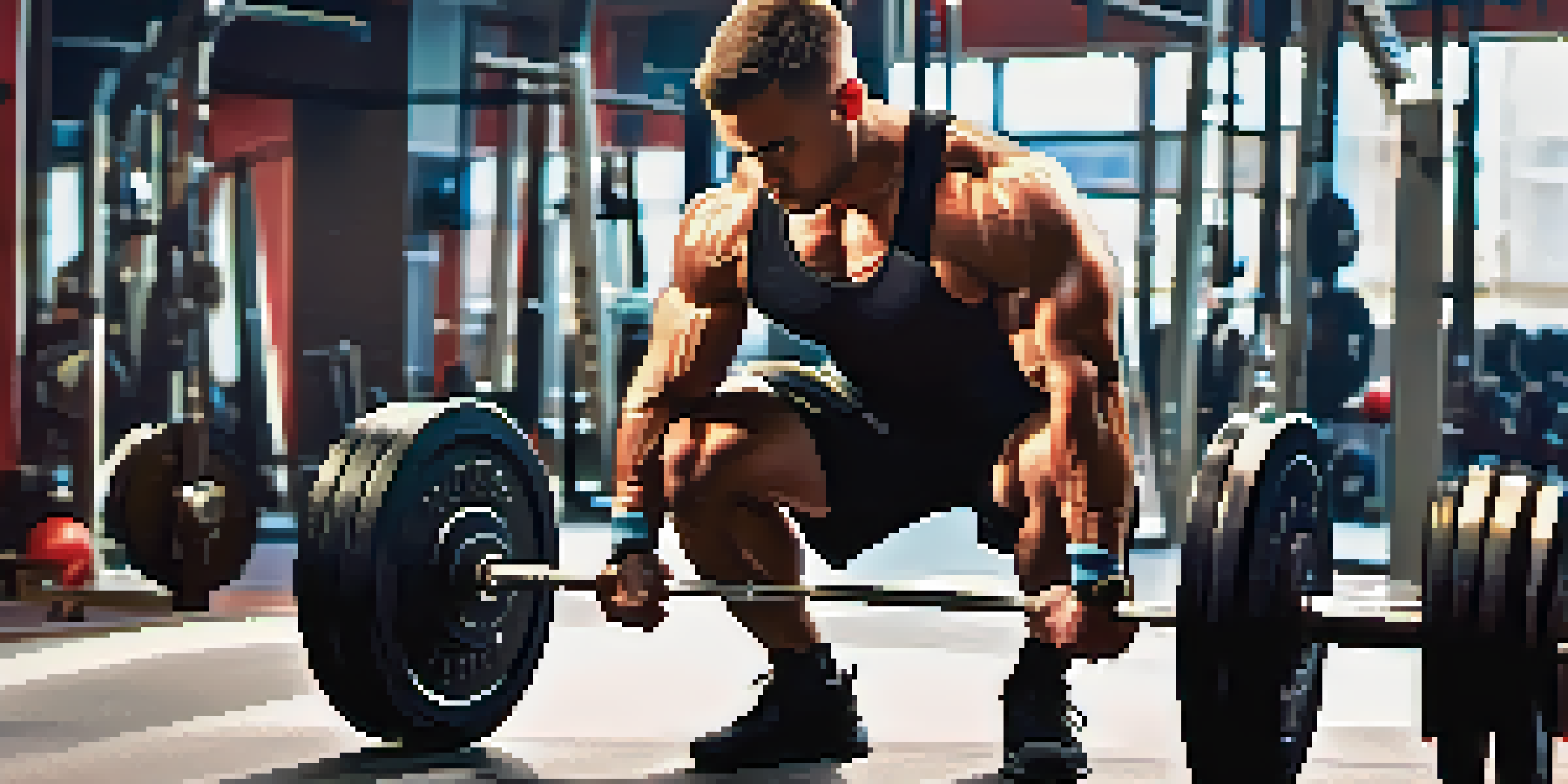Biofeedback and Strength: Improving Powerlifting Performance

Understanding Biofeedback: A Powerful Tool for Athletes
Biofeedback is a technique that allows individuals to gain awareness of their physiological functions. It uses sensors to provide real-time data on body metrics like heart rate, muscle tension, and breathing patterns. By observing this information, athletes can learn to control their bodily responses, which can be particularly beneficial in high-stress environments like powerlifting competitions.
Biofeedback is a powerful tool that can help athletes understand their bodies better and enhance their performance through self-regulation.
Imagine lifting weights while receiving instant feedback on how your body is responding. This awareness can help you adjust your approach, ensuring you're maximizing your performance while minimizing the risk of injury. For powerlifters, this means being able to fine-tune techniques and strategies to enhance strength effectively.
Moreover, biofeedback isn't just about physical performance; it also encompasses mental aspects, such as stress management and focus. By harnessing these tools, powerlifters can create a more holistic approach to their training, leading to improvements in both power and technique.
The Science Behind Biofeedback and Strength Training
At its core, biofeedback relies on the principle of operant conditioning, where feedback from performance can lead to adjustments in behavior. In strength training, this means that by understanding how your body reacts during lifts, you can manipulate your training to achieve optimal results. Research has shown that athletes who utilize biofeedback often experience significant improvements in their performance metrics.

One key aspect of biofeedback is its focus on muscle activation. For example, if a powerlifter notices through biofeedback that a certain muscle group isn't activating as it should, they can adjust their form or training regimen to target that weakness. This targeted approach not only enhances performance but also aids in injury prevention.
Biofeedback Enhances Performance
Athletes can use biofeedback to gain real-time insights into their physiological functions, allowing for improved training techniques and injury prevention.
Additionally, studies suggest that incorporating biofeedback into training can improve mental resilience. By learning to control physiological responses, athletes become more adept at handling the pressure of competition, allowing them to perform at their best when it matters most.
Types of Biofeedback Techniques for Powerlifters
There are several biofeedback techniques that powerlifters can integrate into their training routines. One common method is electromyography (EMG), which measures muscle activity and can help lifters understand which muscles are engaged during their lifts. This insight can guide adjustments to improve overall lifting efficiency.
The key to unlocking athletic potential lies in the connection between mind and body, and biofeedback provides a unique way to strengthen that link.
Another popular technique is heart rate variability (HRV) biofeedback. Monitoring HRV can provide insights into recovery and readiness for training, allowing powerlifters to optimize their workout schedules. By learning to manage stress responses through HRV, athletes can enhance their performance and recovery.
Lastly, breathing techniques are also an essential component of biofeedback. By focusing on breath control, powerlifters can regulate their physiological state, helping them maintain focus and stability during lifts. This simple yet effective practice can lead to substantial improvements in overall performance.
Incorporating Biofeedback into Your Training Regimen
Incorporating biofeedback into your training doesn't have to be complicated. Start by identifying which biofeedback tools resonate with your training goals. Whether it's using an app to monitor heart rate or investing in EMG sensors, the first step is to integrate these tools into your workouts gradually.
As you begin to use biofeedback, it's essential to keep a training log to track your progress and insights. Documenting how your body responds to different lifts and techniques can help you identify patterns and areas for improvement. This personalized approach ensures your training remains effective and tailored to your individual needs.
Various Biofeedback Techniques
Powerlifters can incorporate methods like EMG, HRV, and breathing techniques to optimize their training and recovery processes.
Finally, remember that consistency is key. Regularly using biofeedback tools will help reinforce the connection between your mind and body, leading to improved performance over time. Over time, you'll find that your understanding of your body deepens, giving you a competitive edge in powerlifting.
Real-Life Success Stories: Powerlifters Using Biofeedback
Many powerlifters have experienced remarkable transformations by incorporating biofeedback into their training. For instance, one lifter shared how EMG feedback helped them identify an imbalance in muscle activation during squats, leading to a more effective training plan and a personal record lift. These kinds of success stories highlight the tangible benefits of biofeedback.
Another athlete utilized HRV training to better manage their recovery. By monitoring their heart rate variability, they could optimize their training schedule, ensuring they were well-rested and ready for intense workouts. This strategic approach not only enhanced their performance but also reduced the risk of overtraining.
These examples serve as inspiration for those looking to elevate their powerlifting performance. By adopting biofeedback techniques, lifters can unlock their full potential and achieve their goals more effectively.
Potential Challenges and Limitations of Biofeedback
While biofeedback offers numerous benefits, it's essential to acknowledge potential challenges. For instance, some athletes may initially find the technology overwhelming or distracting. It’s important to approach biofeedback with patience and an open mind, gradually integrating it into your routine to avoid feeling overwhelmed.
Additionally, the effectiveness of biofeedback can vary from person to person. What works wonders for one athlete may not resonate with another. Therefore, it’s crucial to test different techniques and tools to discover what best enhances your performance.
Future of Biofeedback in Training
Advancements in technology and AI are set to revolutionize biofeedback, making personalized training programs more accessible for powerlifters.
Finally, while biofeedback can provide valuable insights, it's just one piece of the puzzle. Athletes should continue to prioritize aspects like nutrition, training consistency, and mental preparation as they work to enhance their overall performance in powerlifting.
The Future of Biofeedback in Strength Training
The future of biofeedback in strength training is bright and full of possibilities. As technology advances, we can expect more sophisticated tools that provide deeper insights into our bodies. Wearable technology, for example, is evolving rapidly, making it easier than ever for powerlifters to access biofeedback data on-the-go.
Moreover, with the rise of artificial intelligence, personalized training programs could be developed based on biofeedback data. This innovation could lead to training regimens specifically tailored to individual needs and goals, revolutionizing how athletes approach their performance.

As the understanding of biofeedback continues to grow, it will likely become a staple in strength training programs. By embracing these advancements, powerlifters can stay ahead of the curve, maximizing their potential and achieving new heights in their performance.